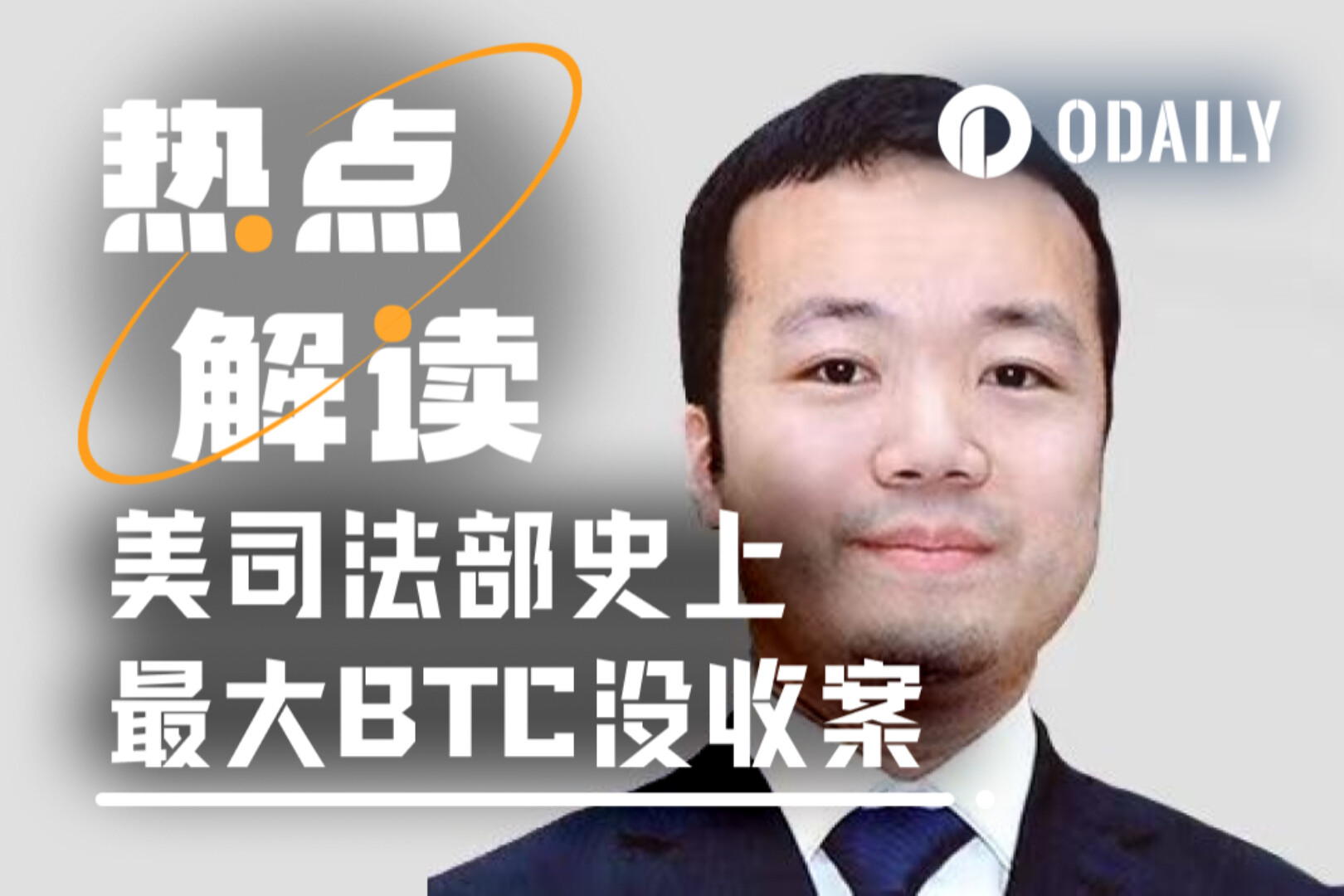近期,RWA 的热度逐渐高涨,甚至被称为下一个牛市的发动机,能翘起一个数 10 万亿的市场。但 RWA 并不是一个新概念,早在 2020 年到 2021 年间就有过一波 FOMO,只不过后续一直不温不火。那么,今年 RWA 为何会再度引起人们的注意?RWA 赛道的热门项目有哪些?RWA 赛道未来发展面临哪些挑战?本文将深入这些问题,揭开 RWA 的神秘面纱。
RWA 概述
RWA 全称是“Real World Assets”,总的来说,一切链下现实世界中的资产代币化后都可以用 RWA 表示。不同于资产证券化打通的是传统资产与资本市场之间的桥梁,RWA 代币化打通的是现实资产与加密金融之间的桥梁,目的就是要将现实世界中的资产带到 DeFi 中来,借助去中心化金融全球可达性的优势给现实资产带来更多的流动性。RWA 的底层资产非常广泛,包括但不限于股票、债券、房地产、现金、艺术品、贵金属、应收账款、保险、投资基金等有形或无形资产。目前占据加密货币市值第三的稳定币 USDT 可以说是最成功的 RWA,即将美元映射到链上并代币化。
RWA 的运行机制
RWA 的运行机制本质上还是在思考如何对链下资产进行恰当估值并引到链上,然后再提供流动性进行交易的问题。
RWA 的运行机制可分为三个步骤,链下资产金融化,金融数据可信化,可信数据代币化。
链下资产金融化:在将链下资产引到链上前必须要先明确资产的经济价值、所有权及其合法性,同时做完这些后还必须考虑如何代币化地表示资产的所有权、使用权及资产的交割方式,让现实资产适应加密金融的体系,而不能简单的扫描几份 PDF 或者法律文件上链。
金融数据可信化:将明晰的资产数据数字化后上链,并写入智能合约。对于 RWA 而言,要在链上实时描绘现实资产的价值必须参考与跟踪外部数据,但是由于区块链只能访问与处理“链上”数据,那么就需要预言机来实现数据连接,向协议提供链下资产价值等数据使链上价格数据可信。同时因为区块链是公开透明的,因此上链后的资产相关数据也是完全公开透明的,虽然这样能使交易更加可信,但完全的公开透明对金融交易并不利,金融机构或者个人并不希望公开其私人的交易。因此,就需要使用零知识证明(ZKP)来解决上述隐私问题,其为我们提供了一个“鱼与熊掌兼得”的解决方案,利用区块链的公共可验证性的同时,也不影响机构或个人专有数据的保密性和隐私性。
可信数据代币化:最后一个步骤便是支持 RWA 的协议向市场或特定投资者发行代币,也可以是 NFT,使 RWA 获得流动性。
RWA 在运行过程中最难的并不是上链,而是上链之前和下链之后。原生链上数据是透明和真实可信的,但桥接到链上的链下资产却可能存在欺诈现象,同时链下资产抵押物的清算也比链上抵押物的清算复杂得多。如何处理好这些问题,缝合好链上与链下之间的裂缝,才是 RWA 运行成功的关键。
RWA 为何又火了?
头部稳定币借贷协议 MakerDAO 在 2020 年就发布了 RWA 相关计划,Aave 在 2021 年也宣布进入 RWA 市场,不过在 2022 年的深熊期间,RWA 渐渐无人问津。解析 RWA 再引关注的原因,我们得先看看 RWA 赛道今年以来发生了哪些大事。
RWA 2023 年大事记
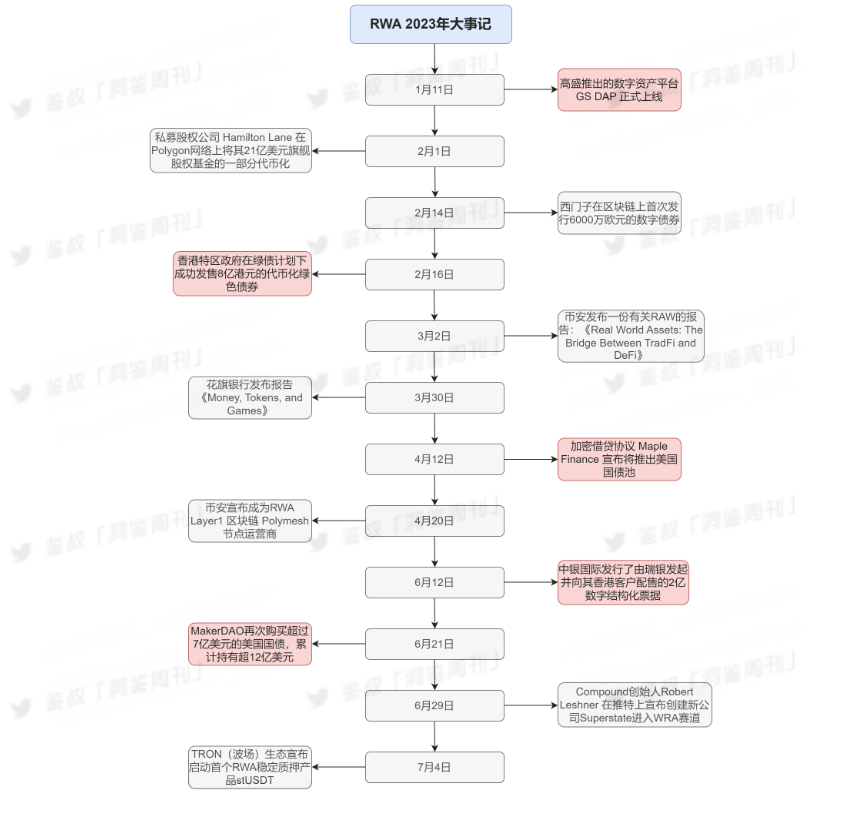
机构入场,一场自上而下的推动
从以上的大事记中也不难看出,今年 RWA 是被如高盛、花旗、币安、MakerDAO 等机构和链上头部协议合力推上舞台的。花旗在其发布的报告《Money、Tokens、and Games》指出,RWA 将会是带动区块链行业进入数 10 万亿美元规模的杀手锏,因为几乎任何能够以价值表示的资产都能被代币化,并且乐观的预计到 2030 年,RWA 的规模将达到 4 万亿美元。
传统金融机构持有大量的现实资产,如股票、债券、房地产等,若是能够将这些资产代币化,就能够增加机构的收益和竞争力,也能为其提供更多投资机会。根据 rwa.xyz 的数据显示,截止 7 月 17 日 RWA 信贷协议总贷款笔数为 1651 ,总贷款额高达 40 多亿,贷款笔数与贷款额之间的悬殊表明 RWA 虽然使传统金融资产有了更高的流动性和全球可达性,但广泛参与的还是机构与企业,而普通投资者并没有多大的参与这个赛道。
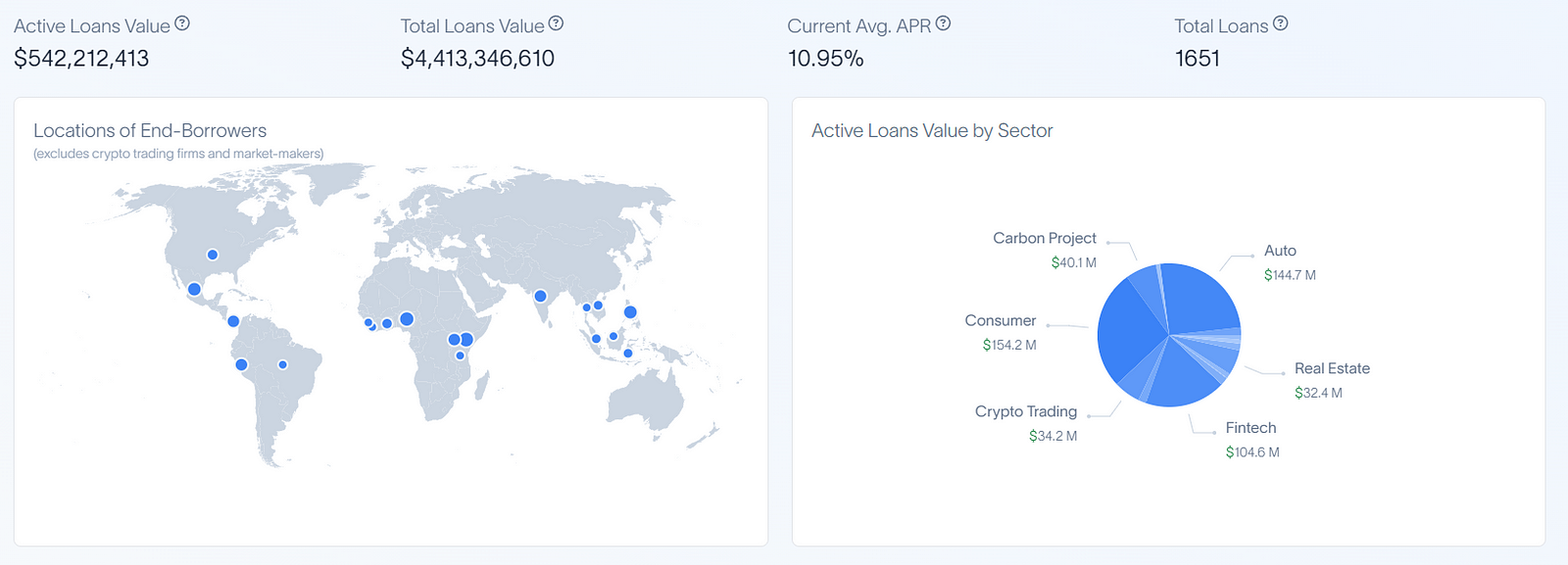
DeFi 收益率下降,低风险债券利率上升
除了机构们自上而下地传播利好外,使链上头部协议与投资者转向 RWA 的重要原因为 DeFi 收益率下降而美债等低风险资产利率上升。截止目前,头部借贷协议 Aave USDT 的存款利率约为 3% ,Compound USDT 的存款利率约为 2.25% ,MakerDAO 的稳定币 DAI 的利率约为 3.49% (数据来源:LoanScan)。
与此同时,伴随着美联储持续加息,美国国债利率正在不断上涨,目前美债一年期以下的利率约 5.3% 左右,已经高于许多链上协议的存款利率。
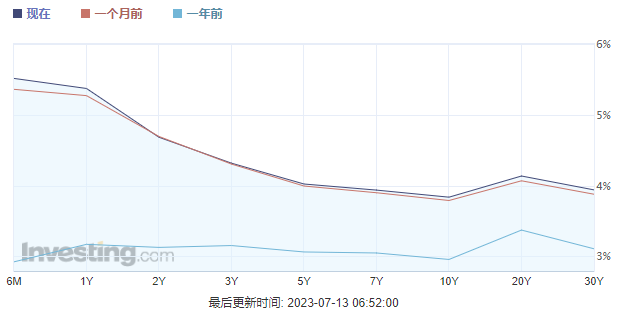
当前市场上的 DeFi 投资者相比于牛市时期追求高利率高收益,随着市场不确定的加剧,已经改变了投资策略,转而追求受加密市场影响较小的稳定收益,美债 5.3% 左右的无风险年化收益,已经足以让投资者们盯上链上美债的收益。根据 rwa.xyz 数据显示,截止 7 月 17 日链上美债的总价值约为 6 亿,加权平均收益率为 4.23% ,加权平均期限小于一年。

深熊恐惧,加密行业急需新叙事
从事加密行业的人们在某种程度上来说是相当团结的,面对现在加密行业暗无天日的深熊,大家都在齐心协力地为走出熊市寻找新的叙事,今年上半年呼声很高的比特币 Ordinals 生态、比特币 ETF 以及 ZKP 的叙事都能看出这种想要跳出泥潭的努力。RWA 打通 TraFi(传统金融)与 DeFi(加密金融)之间的障碍的叙事,也不比前面几个叙事差,给加密行业带来了很大的想象空间。
RWA 赛道热点项目盘点
根据 CoinMarketCap 数据显示,截止 7 月 17 日 RWA 赛道代币总市值超 24 亿美元,其差不多是 DeFi 代币 440 多亿市值的 1/20 ,从这个角度看 RWA 赛道的想象空间还十分巨大。

因为 RWA 定义极广,RWA 赛道涉及 Layer 1、稳定币、借贷、房地产、公共债券、碳信用交易等方向,具体涉及项目 60 多个。以下将盘点 RWA 赛道市值排名前六的热点项目,帮助读者对 RWA 赛道有更深入的认识。(数据来源:CoinMarketCap,统计截止时间 7 月 17 日)
MakerDAO(MKR)
市值超 9 亿美元
MakerDAO 是 2014 年成立的一个以太坊上的去中心化抵押借贷平台,通过将 ETH 等加密资产锁定在智能合约中并铸造与美元挂钩的稳定币 DAI,实现超额抵押贷款。MakerDAO 是最早宣布进入 RWA 赛道的项目之一,在 2020 年就投票通过了基于 RWA 代币化的抵押借贷,扩大了稳定币 DAI。目前 MakerDAO 也在扩大 RWA 赛道的布局,主要是在公共债券方向。
根据 Dune 数据显示,截止目前 MakerDAO 总资产中的 48% 是 RWA,同时有超过 50% 的收入来自于 RWA。MakerDAO 正在从一个传统的 DeFi 协议转向侧重于 RWA 的新方向。

Synthetix(SNX)
市值超 7 亿美元
成立于 2017 年,Synthetix 是目前 RWA 赛道合成资产领域的龙头项目,其旨在提供对现实世界货币、商品、股票和指数的链上敞口。用户可以通过质押 SNX 铸造合成资产(Synths),Synths 跟踪现实世界各种资产的价格。
Synthetix 前后经历三轮融资,投资方包括 Coinbase、DWF Labs 等知名机构。Synthetix 作为合成资产的代表项目,在 2021 年就未能带领 RWA 杀出重围,TVL 从 2021 年 2 月的 29 亿美元下降到目前的 3.8 亿美元。今年 3 月份,Synthetix 新拿到了 DWF Labs 的 2000 万美元融资,且宣布 DWF Labs 将为 SNX 提供流动性与做市商,希望会有所转机。

Centrifuge(CFG)
市值约 1.3 亿美元
成立于 2018 年,Centrifuge 是一个链上信贷协议,旨在为中小企业主提供一种将其资产抵押在链上并获得流动性的方式。借款人可以在没有银行或其他中介机构的情况下为其现实世界资产融资,并为 DeFi 投资者提供与加密货币市场无关的稳定收益来源。
Tinlake 是 Centrifuge 的投资应用程序,其充当现实世界资产池的开放市场。投资者可以查看资产发起人提供的资金池,并投资于适合他们的资金池,目前有 17 个池子。Centrifuge 协议融资总资产 4.21 亿美元了,值得注意的是,Centrifuge 也是 MakerDAO、Aave 等头部抵押借贷协议背后的技术提供方。
Centrifuge 前后经历三轮融资,投资方包括 Coinbase、IOSG 等。
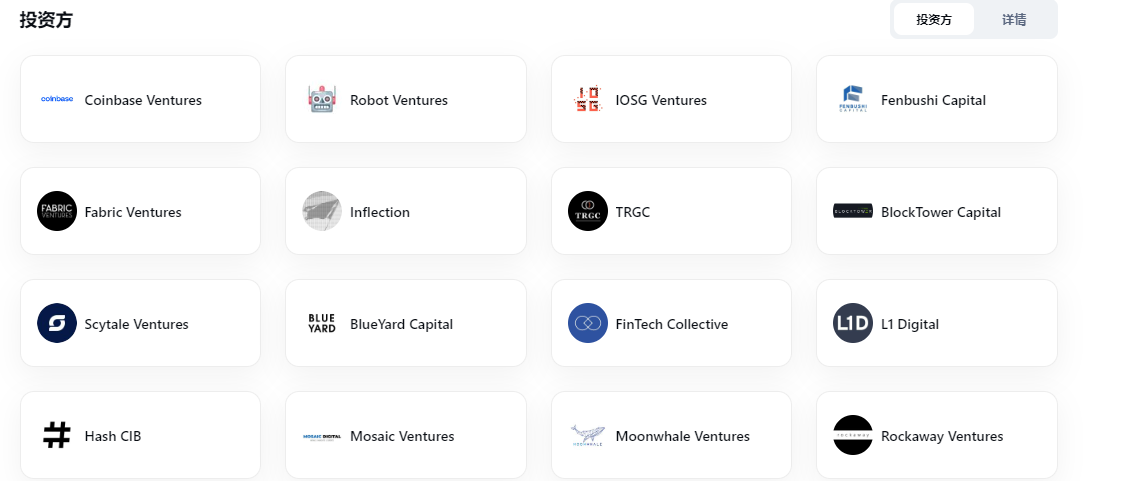
Reserve Rights(RSR)
市值约 1.1 亿美元
成立于 2018 年,Reserve 协议是一个去中心化的稳定币协议,允许用户铸造与美元挂钩的、由任何加密资产支持的稳定币,被称为 RTokens。目前协议已经推出了三种 RTokens,eUSD(电子美元)、ETHPLUS(多样化的 ETH 质押指数)、hyUSD(高收益储蓄美元)。因为其稳定币与美元挂钩,因此属于 RWA 赛道的稳定币方向。
Reserve Rights 并未披露具体的融资细节,但是其投资方阵容却很豪华,包括 Coinbase、OpenAI 创始人 Sam Altman、PayPal 联合创始人 Peter Thiel 等。项目团队的资源相当丰富。
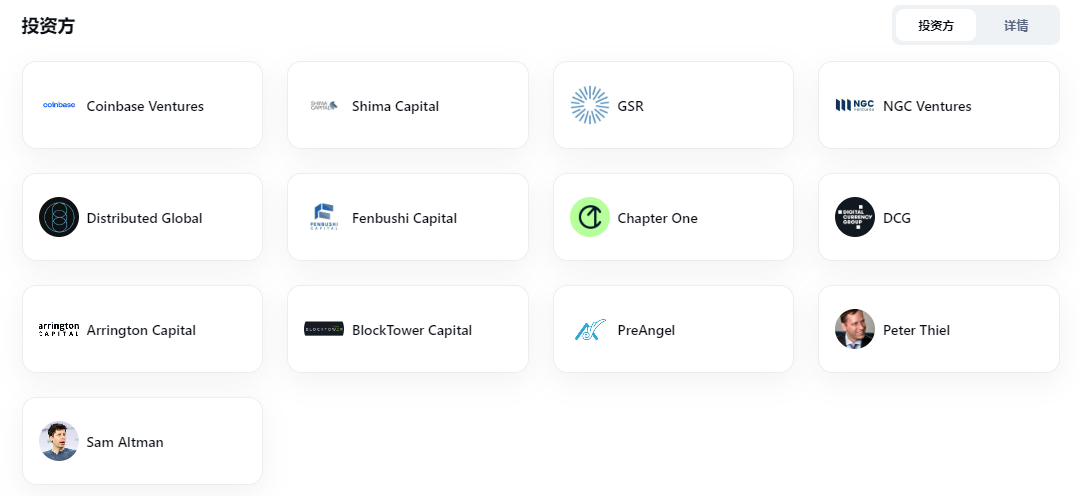
Ribbon Finance(RBN)
市值约 1 亿美元
Ribbon Finance 成立于 2021 年,由 Coinbase 前员工 Julian Koh 创立。Ribbon Finance 也属于 RWA 赛道公共债券方向的项目,其结合了期权、期货和固定收益,力求为 DeFi 投资者提供稳定的收益率。
Ribbon Finance 前后经历两轮融资,参投方包括 Coinbase、Dragonfly 等机构和 Synthetix 创始人 Kain Warwick 等个人投资者。
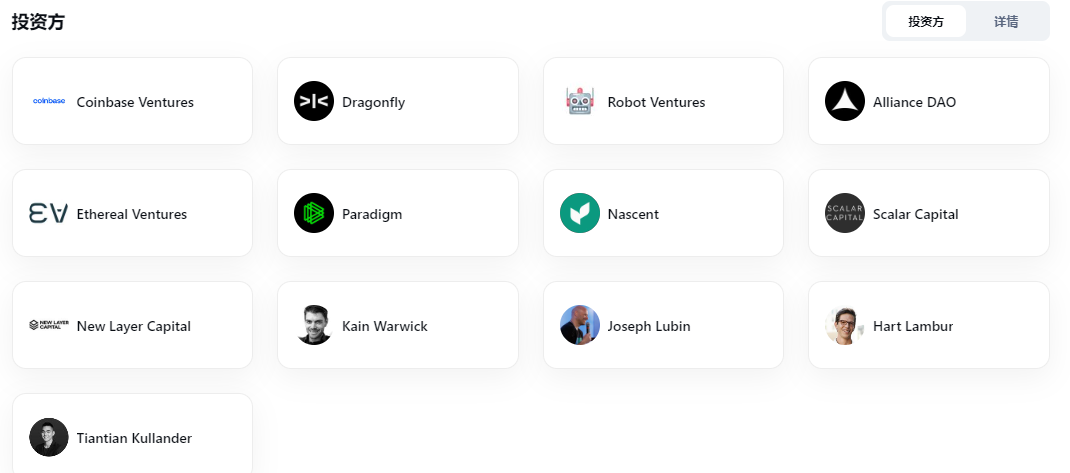
Polymesh(POLYX)
市值约 9760 万美元
因为监管、链下资产管理复杂等因素的限制,原生加密无需可公链如以太坊等很难满足 RWA 的交易需求,因此专为 RWA 赛道服务的垂直公链运应而生。成立于 2020 年的 Polymesh,是一条专门为 RWA 构建的机构级许可区块链,也是目前 RWA 赛道 Layer 1 方向热度与市值最高的项目。
Polymesh 采用了与 polkadot 类似的开发框架,所有的参与者都必须完成 KYC 验证,包括发行商、投资者、节点运营商等,同时其设计的资产管理协议,可以实现机密资产的发行和转移,符合机构们的保密要求。目前 Polymesh 已经有 3.9 K 真实注册用户(因为经过 KYC 验证), 387 M 的 POLYX 在质押, 42 个节点运营商(包括币安)。
从以上 6 个目前 RWA 赛道市值过亿或接近一亿的项目中不难看出,虽然 RWA 目前涵盖范围极广,但投资者们都更加青睐于无形资产的抵押借贷等金融类项目,市值前六中有四个属于这一类,而像涉及房地产、贵金属、艺术品等有形资产的项目却并未能杀出重围得到市场的重视。
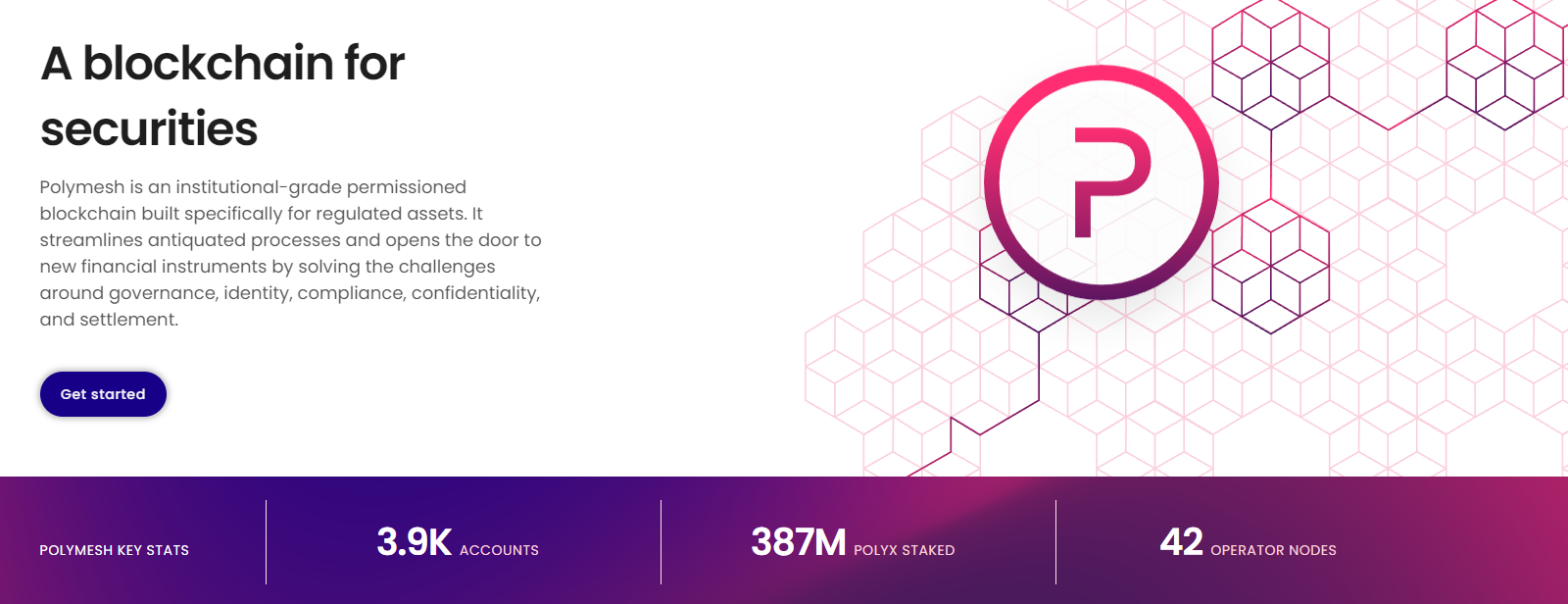
RWA 会再次上演狼来了的故事吗?
因为 RWA 并不是新概念,此轮 RWA 叙事不免有炒冷饭的嫌疑。根据 Dune 数据显示,目前 RWA 各类别交易量加起来远不及上一轮 2021 年时最高峰的交易量。2021 年 10 月左右 RWA 各类别周交易量加起来超过 2.5 亿美元,随后一直萎缩,到目前即使热度再次上升,周交易量也不足 5000 万美元。不禁令人发问,此轮 RWA 又要上演狼来了的故事的吗?

RWA 瞄准的是万亿级别的增量市场,这个饼虽然画得很大,但市场未必吃得下。除了了从交易数据角度,RWA 赛道本事也面临许多挑战。
躲不开的监管
监管对于加密行业永远是个敏感词,RWA 因为与传统金融密切的关系就更加躲不开这个话题。同时,又因为不同国家与地区对 RWA 的监管政策各异,甚至对于各类现实资产的管理方法也不同,如果要想促进 RWA 的全球流通性就要得到各地区监管的支持。因此,RWA 在监管合规方面还有许多要努力的地方,就目前来看,一些对加密行业友好的地区或许会率先尝试。
技术基础设施有待完善
RWA 目前的技术基础设施还有很多需要完善的地方。例如,如何保护经过 KYC 验证的用户的隐私和私人交易数据;如何进行链上链下的数据连接,在区块链上反映现实资产的价值波动;以及结算与交割资产时链上链下的同步问题等。
现实资产估值与真实性问题
对于现实中的资产来说,除了如现金、债券等市场已经估好值的资产外,其他有形资产的市场价格难以估计,很多资产的价格往往要在真实交易过程中才能知道,并且由谁来对实物资产进行估值也是一个问题。同时,链上数据是不会骗人的,但是链下数据的真实性却无法保证,毕竟在传统金融市场上也有大量的数据造假行为。如何识别和杜绝链下资产的造假、欺诈行为,也是 RWA 需要妥善考虑的问题。
RWA 赛道项目发展不均衡
在 RWA 赛道众多的项目中,头部几个稳定币和债券方向的协议市值与收入远超其他方向的项目。这对于一个赛道整体来说是不健康的,投资者目前之所以关注这个赛道是因为 DeFi 收益变低,链上美债项目才如此受欢迎。但如果宏观经济一旦回暖,DeFi 收益变高,加密行业步入牛市,这些 RWA 项目收益率是否还能普遍高于其它 DeFi 协议呢?到那时,没有其他方向项目的支撑,RWA 很难不摆脱昙花一现的宿命。
潜在的违约风险
因为 RWA 赛道的抵押品或者交易资产是链下的,也不是传统 DeFi 协议中的 ERC-20 代币,因此当发生资产清算事件时要比原生加密资产清算复杂得多。根据 rwa.xyz 的数据显示,目前主要的 RWA 协议中,Centrifuge、Maple、TrueFi 均出现了坏账,总违约金额达 6600 多万美元,贷款违约率为 1.6% 左右。

过度的中心化
去中心化是加密行业存在的基石,然而 RWA 目前多倾向于中心化的管理与运营方式,无论是在现实资产审查、资产托管、用户 KYC 验证等方面,甚至很多流程都是由项目方自己执行。如此做固然使 RWA 的运行更加流畅,也更容易符合监管要求,但是过度的中心化也会引发单点信任故障,因此要使 RWA 赛道更加繁荣,需要更多的去中心方案。
总结
加密货币行业一直以来被人们诟病的一点为没有为现实世界带来帮助与价值,DeFi 仅仅使链上资金形成了闭环,NFT 也没有帮助现实世界的品牌形成更多的价值增长。RWA 被机构们强推也是其看到了它对现实资产流动性的帮助,目前债券市场规模为 127 万亿美元左右,全球房地产总价值约为 362 万亿美元,若是能将这些资产与链上形成互动,其创造的价值将是巨大的。
或许在现在的大环境下,下一轮牛市将更加强调合规与对现实世界的实用性。但是,值得注意的是,从以往经验来看,加密行业的每一次爆发大多都是自下而上的引起的,而 RWA 的参与者与受众目前还是以机构和企业为主,普通投资者还没有恰当的切入点。路漫漫其修远兮,RWA 还需要更多的探索尝试。
免责声明:本站所有内容可能涉及项目风险事项,仅供科普与参考之用不构成任何投资建议。请理性看待,树立正确的投资理念,提高防范风险意识。建议在交互与持有之前,综合考虑各种相关因素,包括但不限于个人购买目的以及风险承受能力等。
版权须知:引用信息版权属于原媒体及作者。如未经鉴叔 J Club 同意,其他媒体、网站或个人不得转载本站文章,鉴叔 J Club 保留追究上述行为法律责任的权利。



